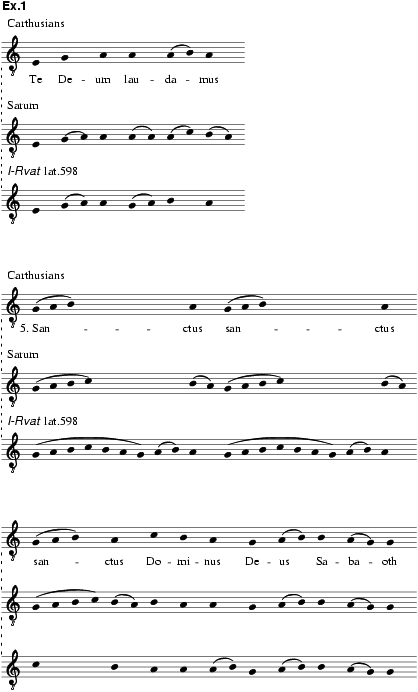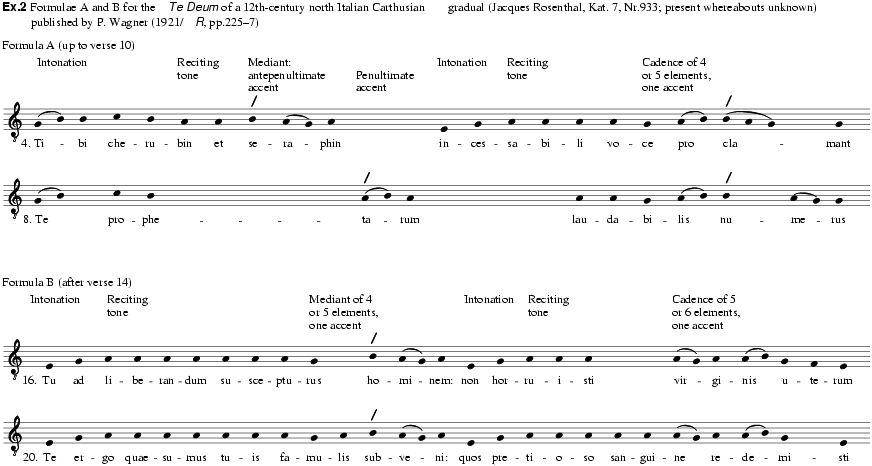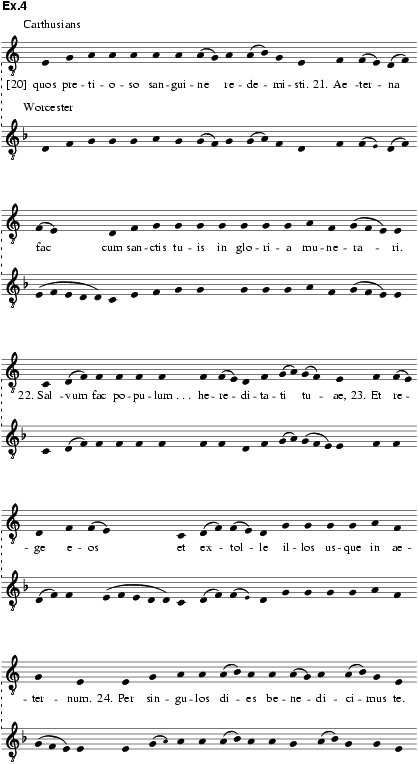
A chant in praise of God sung at the end of Matins on Sundays and feast days, either after the last responsory (the medieval practice) or in its stead (the modern one). It has also been used as a processional chant, the conclusion for a liturgical drama, a song of thanksgiving on an occasion such as the consecration of a bishop, and a hymn of victory on the battlefield. During the Middle Ages it was widely believed that St Ambrose and St Augustine composed the Te Deum as an improvised prayer at the baptism of St Augustine. Some studies have named Niceta of Remesiana the probable author, but the matter remains unsettled.
The text of the Te Deum, seemingly of Latin origin, consists of 29 verses of prose (or 30, depending on how the last verse is treated). In the first ten, which praise God the Father, parallel construction is the rule: ‘Te Deum laudamus, te Dominum confitemur’. The Sanctus of the Mass is quoted in verses 5 and 6; elsewhere the vocabulary and sequence of ideas suggest a connection with the popular hymnody of the 2nd century. Verses 11 to 13 are a doxology and are thought to be a later addition to the basic text. A second section, in praise of Christ, begins with verse 14, ‘Tu rex gloriae Christe’, and continues to verse 23. (Two verses in this section appear to be later additions: verse 15, ‘Tu Patris sempiternus es filius’, and verse 19, ‘Judex crederis esse venturus’.) The last four verses of this section are a prayer; (verses 22 and 23 are borrowed from Psalm xxviii.9 and form the conclusion of what is now regarded as the principal part of the text, about which the manuscript sources are in substantial agreement). The final section, from verse 24 to the end, consists almost entirely of psalm verses that adapt what has preceded them to daily recitation: ‘Per singulos dies benedicimus te’, etc. (Psalm cxliv.2.).
Kähler’s exhaustive analysis of the text reveals important similarities between the Te Deum's principal part (vv.1–23) and the formulae of the Gallican and Mozarabic liturgies. He concluded that the hymn originated before the middle of the 4th century as the Preface, the Sanctus and the prayer following the Sanctus of an old Latin Mass of the Easter vigil, a Mass of baptism. Lending further support to Kähler’s argument are the references to the Te Deum at Gallican festal Matins mentioned in the two earliest descriptions of the Gallican Office, those by the 6th-century bishops of Arles St Caesarius (534–42) and St Aurelian (547–51). The Te Deum’s position at the beginning of the early vigil service in the Ambrosian rite came at a later, though probably still archaic, stage in the canticle's early history.
The regular place for the Te Deum in medieval manuscripts is among the canticles of the Divine Office that are written without musical notation in the appendix to the liturgical psalter. Early manuscripts containing the Te Deum melody written precisely are still urgently sought; the earliest source indicated for any of the published transcriptions currently available is of the 12th century. (The transcriptions in the Solesmes editions, the Liber usualis and the Antiphonale monasticum, are from unspecified sources; Huglo has implied that in at least one respect the version of the Antiphonale monasticum is the ‘original’ one.) There is only one chant melody for the Te Deum, and no significant disagreement among the manuscripts concerning its broad outlines up to the end of verse 20. There are discrepancies of detail, such as differentiate the ‘solemn tone’ and the ‘simple tone’ of the Liber usualis; ex.1 shows how different sources treat the beginning and verse 5 (verses 11 and 13, later additions, begin like verse 5).

Most of the text is chanted to a 4th-mode formula in which the principal reciting note is A. Two versions of the formula are used: the first in verses 1–10 (except for verse 5), the second in verses 14–20. (Omitted from consideration for the present are verses 24–9.) Ex.2 shows these two versions in the Te Deum melody of a 12th-century north Italian Carthusian gradual. In a 13th-century manuscript written in France (the musical supplement to I-Rvat lat.598, quoted by Wagner, 1907, p.67), the beginning of formula A is simplified as in ex.3, although the rest remains essentially the same. In formula B the intonation of the second half of the line is frequently omitted or condensed, but not that of the first half.


It
is interesting to consider the treatment of the second degree of the scale in
formula B (it does not appear in formula A). Wagner's Carthusian source gives
it as F![]() . The
Solesmes editions and the Sarum version of the chant (Harrison, 66) avoid it,
substituting G, the third degree. Other sources, including an important early
one, the Musica enchiriadis (which quotes only one verse of the Te
Deum), clearly indicate a pattern of intervals that would require either
notating the second degree of formula B as F
. The
Solesmes editions and the Sarum version of the chant (Harrison, 66) avoid it,
substituting G, the third degree. Other sources, including an important early
one, the Musica enchiriadis (which quotes only one verse of the Te
Deum), clearly indicate a pattern of intervals that would require either
notating the second degree of formula B as F![]() , or else transposing this part of the chant down a
tone, with D as the final and B
, or else transposing this part of the chant down a
tone, with D as the final and B![]() in the key signature. The 13th-century Worcester
Antiphoner (GB-WO F.160: PalMus, 1st ser., xii, 1922/R, pp.5–6)
opts for the latter solution, but runs into difficulties after verse 20. Verses
21–3 are rather like antiphons in style; if Kähler’s conclusions concerning the
text can be applied also to the music, then they form the original ending of
the chant. In the Carthusian version, and in both Solesmes editions, there is
reciting on G in verses 21 and 23, which have similar melodies, and in verse 22
the reciting is on F. To preserve these relationships, the Worcester Antiphoner
would have had to write E
in the key signature. The 13th-century Worcester
Antiphoner (GB-WO F.160: PalMus, 1st ser., xii, 1922/R, pp.5–6)
opts for the latter solution, but runs into difficulties after verse 20. Verses
21–3 are rather like antiphons in style; if Kähler’s conclusions concerning the
text can be applied also to the music, then they form the original ending of
the chant. In the Carthusian version, and in both Solesmes editions, there is
reciting on G in verses 21 and 23, which have similar melodies, and in verse 22
the reciting is on F. To preserve these relationships, the Worcester Antiphoner
would have had to write E![]() for the reciting note of verse 22; rather than do
this it made several changes (see ex.4).
for the reciting note of verse 22; rather than do
this it made several changes (see ex.4).

Verse 24 marks the beginning of the later supplement to the chant. It opens with the melody of ‘Te Deum laudamus’, blending it into formula B, and this continues until the end of verse 28. The final verse is sung to a more elaborate form of the melody of verse 22. The second degree of formula B of the Te Deum melody posed a difficult problem for notators and analysts of Gregorian chant during the Middle Ages and the Renaissance, and it was not until the late 17th century, in Paris, that chant books offered the simple, precise solution of ex.5.
The earliest known setting of a part of the Te Deum is in the Musica enchiriadis (c880 or earlier), where the verse ‘Tu Patris sempiternus es filius’ is used to illustrate various kinds of parallel organum. A number of references from the 10th to 14th centuries suggest that a festive performance of the Te Deum was normally accompanied by instruments (in particular organ and bells), the normal concomitant of which would be polyphony of some kind. Nevertheless, such polyphony was essentially improvised; no written settings of the Te Deum, apart from the verse just mentioned, are known to have survived from before the early 14th century. From this period comes an isolated setting in an English manuscript (GB-Cgc 334) of the final verse, ‘In te Domine speravi’, with the plainchant in the bass surmounted by two upper parts mostly in parallel movement (ReeseMMA, 339). The harmonies are largely a succession of 6-3 chords, interspersed with 8-5 chords at cadences and elsewhere, and an occasional 10-5 and 5-3 also. Such parallel movement is clearly descended from the earliest forms of organum, and may represent in written form a type of singing more readily improvised, such as Faburden).
15th-century settings are rare. The work by Binchois sets every verse in fauxbourdon, the plainchant paraphrased in the upper part throughout. From England there are early 16th-century settings by Taverner and Sheppard, and an anonymous work based on the faburden of the chant (GB-Lbl Add.17802–5). Aston set a variant of the text, Te matrem Dei laudamus, together with a Te Deum Mass based on the plainchant. Another English work based on the plainchant was Taverner’s antiphon Ave Dei Patris Filia. There are alternatim organ settings by Burton, Redford (two) and Blitheman, and from the Continent a setting in Attaingnant’s sixth collection of keyboard music (1531). Continental liturgical settings of the polyphonic period include works by G.F. Anerio (two), Festa, Kerle (two), Lassus, Morago, Resinarius, Handl and Vaet; and there is the Te Deum Mass by Palestrina. Like the contemporary hymn and Magnificat, the Te Deum was frequently performed in alternatim fashion, plainchant or organ versets alternating with choral polyphony. There are also reports of instrumental ensembles used antiphonally, particularly on festive occasions. At the coronation of Pius III, for example, ‘tibia una et tribus tubis contortis quos trombones vulgo appelant’ responded in turn to the intonations of the Te Deum (C. Mazzi: La Congrega dei Rossi di Siena del secolo XVI, Florence, 1882, p.44).
A new tradition of festive settings was inaugurated in the Baroque era with the large-scale works of Benevoli, Lully, C.H. Graun and others, and continued in the later 18th century with the settings by Giuseppe Sarti, Michael Haydn (who wrote six) and the two by Joseph Haydn. Joseph Haydn’s second work is a remarkably fine piece from 1800 or shortly before, the first of a number of striking compositions of the 19th and 20th centuries. These include works by Berlioz (written for the Paris Exhibition, 1855), Bruckner (1885), Dvořák (1896), Verdi (1898, Paris) and Kodály (1936, written to celebrate the 250th anniversary of the relief of Buda from Turkish occupation).
After the Reformation, settings of the Te Deum in English occupied a regular place in the Anglican Service; there is a modified version of its melody in Merbecke’s Booke of Common Praier Noted (1550). Luther’s version, Herr Gott dich loben wir, also based on the Gregorian melody, gave rise to such widely diverse settings as the six by Michael Praetorius, the organ settings of Scheidt (Tabulatur-Buch, 1650), Buxtehude and J.S. Bach, and Bach’s four-part chorale version in the edition of C.P.E. Bach.
The
tradition of festal settings in English begins with Purcell’s of 1694 (for St
Cecilia’s Day, with Jubilate) and continues with those of Handel
(‘Utrecht’, 1713, and ‘Dettingen’, 1743), Sullivan (1900), Parry (1911),
Stanford (B![]() , 1898) and
Walton (1953). Parry and Stanford also wrote Latin works (1898, 1900) and Parry
revised his Latin setting to English words for performance in 1913. Walton’s
piece, a distinguished contribution to the genre, was written for the
coronation of Queen Elizabeth II.
, 1898) and
Walton (1953). Parry and Stanford also wrote Latin works (1898, 1900) and Parry
revised his Latin setting to English words for performance in 1913. Walton’s
piece, a distinguished contribution to the genre, was written for the
coronation of Queen Elizabeth II.
HarrisonMMB; MGG1 (K.H. Schlager); ReeseMMA; ReeseMR
J. Julian: A Dictionary of Hymnology (London, 1892, 2/1907/R)
A. Gastoué: ‘Le “Te Deum”’, Revue de chant grégorien, xiv (1905–6), 129–35
P. Wagner: ‘Das Te Deum’, Gregorianische Rundschau, vi (1907), 49–55, 65–70, 81–5, 98–104, 114–18
P. Wagner: Einführung in die gregorianischen Melodien, iii: Gregorianische Formenlehre (Leipzig, 1921/R)
M. Righetti: Manuale di storia liturgica, i (Milan, 1945, 3/1964)
E. Kähler: Studien zum Te Deum und zur Geschichte des 24. Psalms in der alten Kirche (Göttingen, 1958)
K. Levy: ‘The Byzantine Sanctus and its Modal Tradition in East and West’, AnnM, vi (1958–63), 1–67
W. Kirsch: Die Quellen der mehrstimmigen Magnificat- und Te Deum-Vertonungen bis zur Mitte des 16. Jahrhunderts (Tutzing, 1966)
B.J. Blackburn: ‘Te Matrem Dei laudamus: a Study in the Musical Veneration of Mary’, MQ, liii (1967), 53–76
M. Huglo: ‘Te Deum’, New Catholic Encylopedia (New York, 1967)
J. Caldwell: ‘The “Te Deum” in Late Medieval England’, EMc, vi (1978), 188–94
J. Aplin: ‘The Survival of Plainsong in Anglican Music: Some Early English Te-Deum Settings’, JAMS, xxxii (1979), 247–75
RUTH STEINER/KEITH FALCONER (1, 2), JOHN CALDWELL (3)